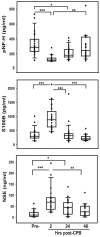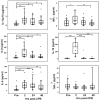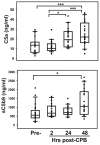Brain injury with systemic inflammation in newborns with congenital heart disease undergoing heart surgery
- PMID: 28672919
- PMCID: PMC5488503
- DOI: 10.3892/etm.2017.4493
Brain injury with systemic inflammation in newborns with congenital heart disease undergoing heart surgery
Abstract
The potential role of systemic inflammation on brain injury in newborns with congenital heart disease (CHD) was assessed by measuring levels of central nervous system (CNS)-derived proteins in serum prior to and following cardiac surgery. A total of 23 newborns (gestational age, 39±1 weeks) with a diagnosis of CHD that required cardiac surgery with cardiopulmonary bypass (CPB) were enrolled in the current study. Serum samples were collected immediately prior to surgery and 2, 24 and 48 h following CPB, and serum levels of phosphorylated neurofilament-heavy subunit (pNF-H), neuron-specific enolase (NSE) and S100B were analyzed. Systemic inflammation was assessed by measuring serum concentrations of complement C5a and complement sC5b9, and the following cytokines: Interleukin (IL)-1β, IL-6, IL-8, IL-10, IL12p70, interferon γ and tumor necrosis factor (TNF)-α. Analysis of cord blood from normal term deliveries (n=26) provided surrogate normative values for newborns. pNF-H and S100B were 2.4- to 2.8-fold higher (P<0.0001) in patient sera than in cord blood prior to surgery and remained elevated following CPB. Pre-surgical serum pNF-H and S100B levels directly correlated with interleukin (IL)-12p70 (ρ=0.442, P<0.05). pNF-H was inversely correlated with arterial pO2 prior to surgery (ρ=-0.493, P=0.01) and directly correlated with arterial pCO2 post-CPB (ρ=0.426, P<0.05), suggesting that tissue hypoxia and inflammation contribute to blood brain barrier (BBB) dysfunction and neuronal injury. Serum IL12p70, IL-6, IL-8, IL-10 and TNF-α levels were significantly higher in patients than in normal cord blood and levels of these cytokines increased following CPB (P<0.001). Activation of complement was observed in all patients prior to surgery, and serum C5a and sC5b9 remained elevated up to 48 h post-surgery. Furthermore, they were correlated (P<0.05) with low arterial pO2, high pCO2 and elevated arterial pressure in the postoperative period. Length of mechanical ventilation was associated directly with post-surgery serum IL-12p70 and IL-8 concentrations (P<0.05). Elevated serum concentrations of pNF-H and S100B in neonates with CHD suggest BBB dysfunction and CNS injury, with concurrent hypoxemia and an activated inflammatory response potentiating this effect.
Keywords: S100B; cardiopulmonary bypass; cytokines; neonates; neuron specific enolase; phosphorylated neurofilament heavy chain.
Figures





References
-
- Marino BS, Lipkin PH, Newburger JW, Peacock G, Gerdes M, Gaynor JW, Mussatto KA, Uzark K, Goldberg CS, Johnson WH, Jr, et al. Neurodevelopmental outcomes in children with congenital heart disease: Evaluation and management: A scientific statement from the American heart association. Circulation. 2012;126:1143–1172. doi: 10.1161/CIR.0b013e318265ee8a. - DOI - PubMed
LinkOut - more resources
Full Text Sources
Other Literature Sources
Medical
Miscellaneous
